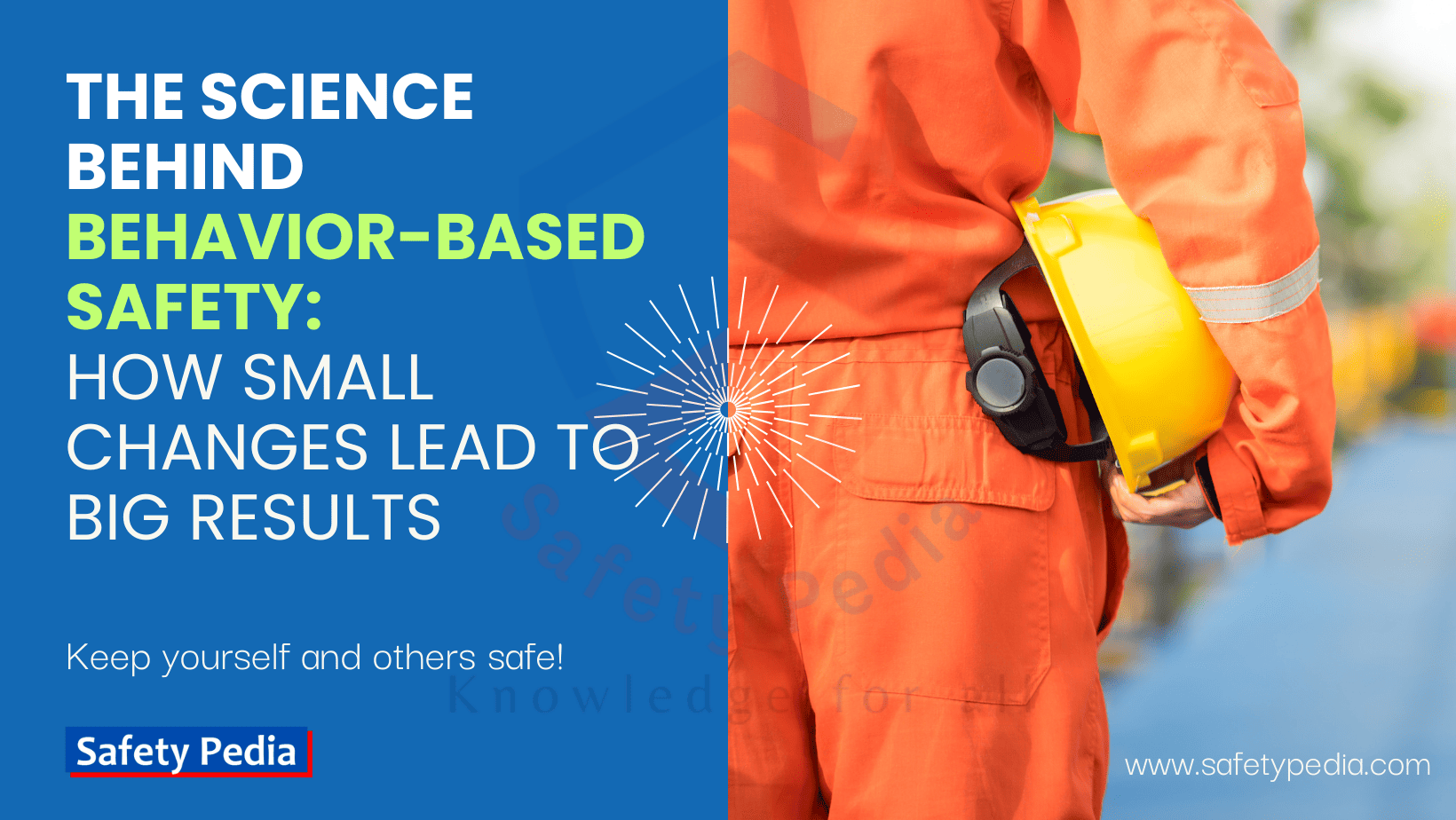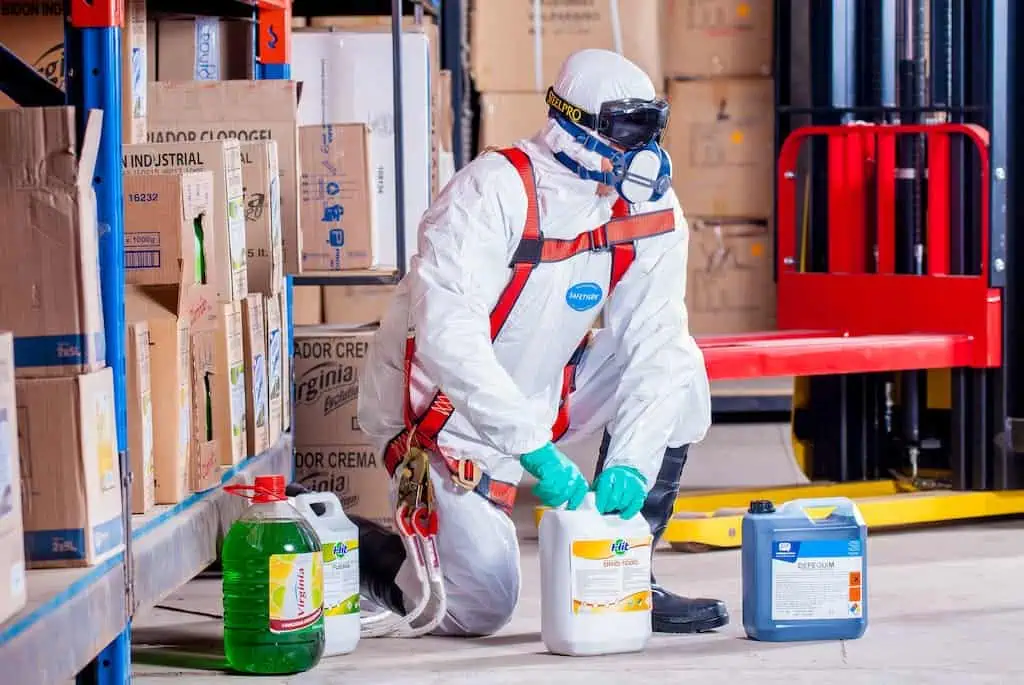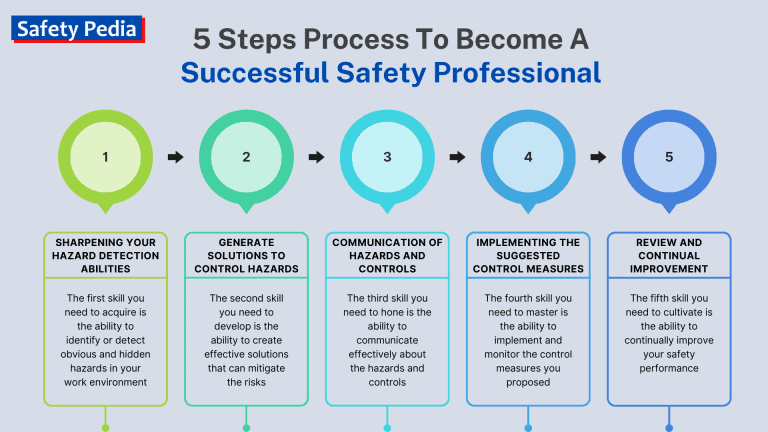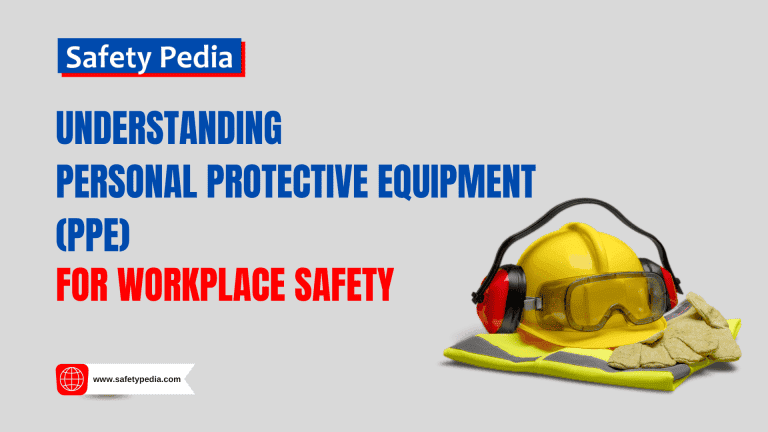
Introduction: Behavior-Based Safety
In workplace safety, small changes can lead to big results. Understanding the science behind behavior-based safety is crucial for organizations looking to create a safer work environment. Companies adopting behavior-based safety (BBS) can significantly reduce accidents and injuries while promoting a safety culture.
Behavior-based safety is rooted in the belief that human behavior is the primary cause of occupational accidents and injuries. This approach recognizes that by modifying and positively influencing employee behavior, organizations can prevent incidents before they occur.
Incorporating small changes, such as providing clear instructions, rewarding safe behaviors, and conducting regular training sessions, can significantly impact overall safety outcomes. By focusing on employee behaviors and their underlying causes, companies can identify potential hazards, implement targeted interventions, and continuously improve safety performance.
This article explores the science behind behavior-based safety, examining its principles and strategies for implementation. Discover how small changes in employee behavior can lead to big results in creating a safer work environment.
Understanding behavior-based safety
Behavior-based safety (BBS) is a proactive approach that focuses on identifying and modifying individual behaviors contributing to workplace safety. Unlike traditional safety programs that focus solely on physical hazards, behavior-based safety recognizes the importance of modifying and positively influencing employee behavior to prevent incidents before they occur. This understanding is critical because it recognizes that most workplace incidents result from human actions rather than equipment failure or environmental conditions.
One of the key principles of behavior-based safety is the observation of employees in their work environment. This involves monitoring how tasks are performed and identifying safe and unsafe behaviors. Peers or supervisors can conduct observations, and these assessments are crucial for providing feedback. The goal is not to reprimand but to educate and guide employees toward safer practices. This approach encourages a culture of openness, where employees feel comfortable discussing safety concerns and sharing their experiences. It builds trust within teams and encourages collaboration to promote safety.
Organizations can implement targeted interventions to address the underlying causes by understanding why employees engage in unsafe behaviors. This proactive approach reduces accidents and injuries and enables a safety culture where employees create a safer work environment.
Furthermore, BBS programs often utilize data collection and analysis to track behavior trends over time. By systematically gathering this information, organizations can identify patterns and pinpoint areas for improvement. For instance, if data reveals that a specific task frequently leads to unsafe behavior, the organization can delve deeper into the task procedures, redesign the job, and provide training to enhance safety. Ultimately, behavior-based safety emphasizes continuous improvement and adaptation, making it a dynamic part of an organization’s overall safety strategy.
The Importance of Creating a Safer Workplace
Creating a safer workplace is not just a regulatory obligation; it is essential for the well-being of employees and the overall success of an organization. A safe work environment correlates with employee morale, productivity, profitability, and retention. When employees feel safe, they are more likely to engage fully in their tasks and contribute positively to the company culture. Conversely, unsafe work environments can lead to increased absenteeism, lower job satisfaction, and higher turnover rates, significantly impacting productivity and profitability.
Moreover, organizations with strong safety cultures often experience fewer workplace accidents, which can lead to substantial financial savings. Costs associated with workplace incidents, such as medical expenses, legal fees, and lost productivity, can be crippling. Organizations can mitigate these risks and protect their bottom line by prioritizing safety. Additionally, a commitment to safety enhances the company’s reputation, making it more attractive to potential employees and clients. In an era where corporate social responsibility is increasingly essential, demonstrating a commitment to employee safety can differentiate an organization from a competitive market.
Furthermore, implementing a culture of safety aligns with ethical business practices. Organizations have a moral responsibility to protect their employees and create an environment where they can manuaver and work without fear of harm. This ethical commitment can promote loyalty among employees, who are likelier to remain with a company that prioritizes their well-being. As a result, investing in safety is not just a strategic decision; it is a fundamental component of responsible business operations that benefits everyone involved.
Definition of Behavior-Based Safety
Behavior-Based Safety (BBS) is a proactive approach focusing on observing individual behaviors, analyzing the consequences, and reinforcing safe practices to reduce workplace accidents and injuries. It recognizes that human behavior plays a crucial role in workplace safety and aims to create a safety culture by actively addressing and influencing individual actions.
Here’s a breakdown of the key aspects of BBS:
- Observation and Analysis: BBS systematically observes employees performing their tasks to identify safe and unsafe behaviors.
- Focus on Behavior: BBS shifts from solely addressing hazards and implementing control measures to understanding and modifying the behaviors that influence safety incidents.
- Employee Involvement: Actively engaging workers in identifying risks and developing solutions to promote safety.
- Positive Reinforcement: Providing immediate constructive feedback, offering guidance and support to encourage safe behaviors, discouraging unsafe practices, and correcting unsafe ones who exhibit unsafe behaviors.
- Data Analysis: Collecting and analyzing behavioral data to identify trends and implement targeted safety interventions.
- Continuous Improvement: BBS is an ongoing process that involves continuous improvements and adjusting strategies based on the results.
The Behavior-Based Safety (BBS) Process
The Behavior-Based Safety (BBS) process is a continuous cycle that aims to improve safety performance. Here’s a breakdown of the key steps in the process:
1. Define and prioritize target behaviors:
- Identify specific behaviors that are critical for safety in your workplace. This could include using proper personal protective equipment (PPE), following safe work procedures, or maintaining a clean and organized work environment.
- Prioritize the target behaviors based on their potential impact on accident prevention and their feasibility to address.
2. Develop a data collection plan:
- Choose a method for observing and recording employee behaviors. This could involve direct observation, self-reporting, or video recording (with employee consent).
- Design a data collection form that captures information about the observed behavior, the context in which it occurred, and the potential consequences.
3. Conduct observations:
- Train observers to ensure consistency and objectivity in their observations.
- Conduct observations in a representative sample of work activities across different work areas.
- Maintain confidentiality of the information collected and protect employee privacy.
4. Analyze data and identify trends:
- Analyze the collected data to identify patterns and trends in employee behaviors.
- Look for areas where unsafe behaviors are prevalent or where safe behaviors fall short of expectations.
5. Develop and implement interventions:
- Based on the data analysis, develop interventions to influence and improve employee behaviors.
- Interventions may include:
- Positive reinforcement: Recognizing and rewarding safe behaviors.
- Feedback and coaching: Providing constructive feedback on observed behaviors and offering suggestions for improvement.
- Training and awareness programs: Educating employees about the importance of safety and the specific safe behaviors expected of them.
- Engineering controls: Modifying the work environment or equipment to reduce the opportunity for unsafe behaviors.
6. Evaluate and refine:
- Regularly evaluate the effectiveness of your BBS program by comparing pre- and post-intervention data.
- Monitor changes in safety performance and employee behavior.
- Refine your interventions and data collection methods based on the evaluation results to ensure continuous improvement.
Remember:
- Engage employees throughout the process: Involve employees in identifying target behaviors, developing interventions, and evaluating the program’s effectiveness.
- Maintain a positive and supportive environment: Focus on positive reinforcement and collaboration to create a culture of safety where employees feel comfortable reporting unsafe behaviors and seeking help.
- Flexibility is key: Adapt and refine your BBS program to address your evolving needs and workplace context.
By following these steps and continuously adapting, you can create a successful BBS program that leads to a safer and healthier work environment for everyone.

5 Goals of the Behavior-Based Safety (BBS) Process:
- Reduce workplace accidents and injuries.
- Create a culture of accountability and safety awareness.
- Enhance employee engagement in maintaining a safe work environment.
- Identify and eliminate barriers to safe behaviors.
- A strong safety culture can lead to improved productivity, quality, and customer satisfaction.
The Psychology Behind Behavior Change
To effectively implement behavior-based safety, it’s crucial to understand the psychology behind behavior change. Various factors influence human behavior, including personal beliefs, attitudes, shared values, norms, traditions, education, and the environment. By tapping these factors, organizations can design interventions that promote safe behaviors and discourage risky ones.
One key concept in behavior change is the theory of planned behavior. This theory suggests that an individual’s intention to engage in a behavior is influenced by their attitude toward the behavior, subjective norms, and perceived behavioral control. By addressing these factors, organizations can motivate employees to adopt safe behaviors and make them a part of their daily routines.

Behavior-Based Safety Approach
While Behavior-Based Safety (BBS) focuses on observing, analyzing, and influencing behaviors, several different approaches exist within the umbrella of BBS. Here are some common approaches:
1. ABC Model (Antecedents, Behaviors, and Consequences):
- The ABCs of behavior-based safety refer to three key components: antecedents, behaviors, and consequences. Antecedents are the triggers or stimuli that precede a behavior, while behaviors are individuals’ actions. Consequences, on the other hand, are the outcomes that follow a behavior.
- This approach focuses on identifying the factors that trigger unsafe behaviors (antecedents), the actual unsafe behaviors themselves (behaviors), and the outcomes (consequences) of those behaviors. This analysis helps understand the “why” behind unsafe acts and allows interventions to address the root causes.
- By understanding the ABCs, organizations can identify the antecedents that lead to unsafe behaviors and implement strategies to modify them. For example, providing clear instructions and training can serve as antecedents that promote safe behaviors, while consequences such as recognition and rewards can reinforce those behaviors.
2. Positive Reinforcement:
- This approach emphasizes rewarding and recognizing safe behaviors to encourage their repetition. This can include verbal praise, public recognition, awards, or even small incentives.
- Positive reinforcement aims to create a positive association with safe practices, making them more likely to be adopted by employees.
3. Peer-to-Peer Observation:
- This approach involves training designated employees to observe and provide feedback to their peers on their safety behaviors.
- This can encourage a sense of ownership and accountability among employees, encouraging them to look out for each other’s safety.
4. Self-Observation:
- This approach involves training employees to observe and analyze their own safety behaviors.
- This empowers individuals to take responsibility for their safety and identify areas for improvement.
5. Systems-Based Approach:
- This approach recognizes that organizational factors can also influence behavior. It integrates BBS with other safety initiatives, such as engineering controls and safe work procedures, to create a comprehensive safety management system.
Choosing the right approach depends on the specific needs of the organization and its workforce. Some organizations may combine these approaches for a comprehensive and targeted BBS program.
The role of leadership in behavior-based safety
Leadership is crucial in creating a safety culture and driving behavior-based safety initiatives. Leaders must demonstrate a solid commitment to safety at all levels of the organization. This commitment is not just about enforcing rules; it involves actively participating in safety initiatives, providing resources, and promoting a culture prioritizing safety. When management visibly supports safety efforts, it sends a powerful message to employees that their well-being is a top priority, which can significantly influence their attitudes and behaviors regarding safety.
Effective communication is another critical management responsibility when promoting behavior-based safety. Leaders should regularly communicate safety expectations, share success stories, and provide updates on safety initiatives. This transparency keeps safety at the forefront of employees’ minds and encourages them to engage in safe practices.
Moreover, management should be approachable and open to employee feedback regarding safety concerns. This two-way communication nurtures a collaborative environment where employees feel empowered to voice their opinions and contribute to safety improvements.
Management should prioritize the training and development of employees in behavior-based safety principles. Management should also encourage employees to participate in safety observation and feedback processes. When employees are actively involved in safety initiatives, they are more likely to take ownership of their safety and that of their colleagues, leading to a more robust safety culture.
In addition to setting the tone, leaders should empower employees to take ownership of safety. This can be done by involving employees in safety committees, soliciting their input on safety initiatives, and providing them with the necessary resources and support to promote safe behaviors.

Implementing behavior-based safety in the workplace
Implementing behavior-based safety requires a systematic approach that involves multiple stakeholders. The first step is to thoroughly assess the current safety culture and identify areas for improvement. This assessment can involve surveys, interviews, and observations to gain insights into existing behaviors and practices. Understanding the existing culture will help organizations tailor their BBS initiatives to address specific needs and challenges.
Once the assessment is complete, organizations can develop a comprehensive action plan with clear objectives, specific goals, strategies, and timelines for the behavior-based safety program. This plan should address the identified areas for improvement and outline the steps to promote safe behaviors. These objectives should be measurable and aligned with the overall safety goals of the organization. For instance, an objective might be to reduce the number of unsafe behaviors observed in a particular department by a certain percentage within a specified timeframe. Setting clear goals helps create accountability and allows organizations to track progress effectively.
The next phase involves training employees on behavior-based safety principles and the importance of observation and feedback. Employees should understand how their behaviors impact safety and learn to recognize safe and unsafe practices. Organizations can facilitate workshops, seminars, and hands-on training sessions to engage employees actively. Additionally, it is crucial to establish a system for conducting observations and providing feedback. This system should emphasize positive reinforcement, recognizing safe behaviors, and addressing unsafe practices constructively.
Training and education for behavior-based safety
Training and education are cornerstones of successful behavior-based safety programs. To promote a culture of safety, organizations must ensure that all employees receive thorough training on BBS principles and practices. This training should cover the rationale behind behavior-based safety, how to conduct observations, and the importance of providing constructive feedback. By equipping employees with this knowledge, organizations empower them to take an active role in promoting safety in their workplace.
Moreover, training should not be a one-time event but rather an ongoing process. Regular refresher courses, workshops, and safety meetings can help reinforce behavior-based safety principles and keep safety at the forefront of employees’ minds. Organizations should also consider utilizing various training formats, such as e-learning, hands-on demonstrations, and group discussions, to cater to different learning styles and engage employees effectively. This diverse approach can enhance retention and application of safety knowledge in real-world scenarios.
Additionally, organizations should encourage employees to share their experiences and insights during training sessions. Organizations can promote a sense of ownership and accountability by promoting an environment where employees feel comfortable discussing safety challenges and successes. This collaborative approach enhances the effectiveness of training and builds a strong foundation for a culture of safety that permeates the entire organization.

Measuring and evaluating behavior-based safety programs
Measuring and evaluating their impact is essential to ensure the effectiveness of behavior-based safety programs. This can be done through various methods, such as incident reporting, near-miss reporting, and safety observations. By analyzing these data, organizations can identify trends, patterns, and areas for improvement.
In addition to lagging indicators, organizations should also track leading indicators that measure proactive safety behaviors. These indicators can include the number of safety suggestions submitted, the participation rate in safety training, and the frequency of safety observations conducted. Regular evaluation and feedback allow organizations to make data-driven decisions and improve their safety performance.
The Benefits of Behavior-Based Safety
The implementation of behavior-based safety programs offers numerous benefits that extend beyond mere compliance with regulations. One of the most significant advantages is reducing workplace incidents and accidents. Organizations can identify and mitigate risks by focusing on individual behaviors and promoting a proactive safety culture before they lead to injuries. This reduction in incidents protects employees and saves organizations from the financial burdens associated with accidents, including medical costs, legal fees, and lost productivity.
Furthermore, behavior-based safety programs can enhance employee engagement and morale. When employees actively participate in safety initiatives and feel empowered to contribute to a safer workplace, their job satisfaction increases. This engagement fosters a positive organizational culture where employees are more likely to collaborate, communicate openly, and support one another in maintaining safety standards. A motivated workforce is more productive, leading to improved overall performance for the organization.
Another significant benefit is the improvement in the organization’s reputation and competitiveness. Companies that prioritize safety and demonstrate a commitment to employee well-being are often viewed more favorably by clients, partners, and potential employees. This positive reputation can enhance customer loyalty and attract top talent, providing the organization a competitive edge in the market. A strong safety culture can significantly influence an organization’s success in a landscape where corporate responsibility is increasingly valued.
- Reduced accident rates: BBS can significantly decrease workplace accidents and injuries by addressing unsafe behaviors.
- Improved safety culture: BBS enables a culture where safety is prioritized, leading to increased employee engagement and participation in safety initiatives.
- Cost savings: By preventing accidents, BBS can help companies save money on associated costs such as medical expenses, lost productivity, and workers’ compensation claims.
- Increased employee morale: A safe work environment can improve employee morale, increase job satisfaction, and lower turnover rates.
Case Studies and Success Stories In Behavior-Based Safety Programs
Real-life case studies and success stories can provide valuable insights and inspiration for organizations looking to implement behavior-based safety. These stories highlight how small changes in employee behavior can significantly improve safety outcomes.
Several organizations have successfully implemented behavior-based safety programs, significantly improving workplace safety and employee engagement. One notable example is a manufacturing company that faced a high rate of workplace injuries due to unsafe behaviors. The organization implemented a BBS program focused on employee observations and feedback. They trained employees to conduct peer observations and provide constructive feedback on safety practices. Within a year, the company reported a 50% reduction in workplace injuries, demonstrating the effectiveness of its BBS initiatives.
Another compelling case involves a construction firm integrating behavior-based safety into its daily operations. The company emphasized the importance of safety in its corporate culture and engaged employees at all levels in safety discussions. They established regular safety meetings and encouraged employees to share their observations and suggestions. This collaborative approach led to a significant decline in accidents and cultivated a sense of community among employees. The firm became known for its commitment to safety, attracting clients who valued responsible business practices.
A healthcare organization also witnessed remarkable results after adopting behavior-based safety principles. Facing challenges related to staff injuries and patient safety incidents, the organization implemented a BBS program that promoted safe behaviors among healthcare workers. Employees learned to identify risks and take proactive measures to prevent incidents through training and ongoing support. The result was a significant decrease in staff injuries and adverse patient events, illustrating the transformative impact of behavior-based safety in a high-stakes environment.
For example, a manufacturing company successfully reduced the number of hand injuries by implementing a behavior-based safety program emphasizing the proper use of personal protective equipment and hand safety techniques. The company created a safer work environment by providing training, conducting regular safety observations, recognizing employees for their safe behaviors, and reducing hand injuries by 50% within a year.
Here are a few examples of how BBS has been implemented successfully across different industries, demonstrating its positive impact on safety performance and employee engagement:
1. Reducing Slips, Trips, and Falls in Manufacturing:
- Company: Large automotive manufacturer
- Challenge: Frequent slips, trips, and falls (STFs) were a major concern, leading to injuries and lost productivity.
- Intervention: Implemented a BBS program to observe and encourage safe walking practices, housekeeping, and proper footwear usage.
- Results: Reduced STF incidents by 50% within the program’s first year and sustained improvements over time.
2. Improving Hand Safety in Construction:
- Company: Construction contractor specializing in high-rise buildings
- Challenge: Hand injuries were prevalent due to improper use of personal protective equipment (PPE) and unsafe handling of tools.
- Intervention: Introduced a BBS program focusing on observing and reinforcing the correct use of gloves, following safe tool-handling practices, and promoting hand hygiene.
- Results: Decreased hand injuries by 70% within two years, leading to significant cost savings on medical expenses and lost workdays.
3. Enhancing Hospital Staff Safety:
- Organization: Large hospital network
- Challenge: Patient handling and lifting tasks posed a risk of back injuries for nurses and other healthcare professionals.
- Intervention: Implemented a BBS program incorporating observations, peer-to-peer coaching, and training on proper ergonomics and lifting techniques.
- Results: Reduced the number of musculoskeletal disorders by 30% within a year and encouraged a culture of safety among staff.
4. Boosting Safety in the Hospitality Industry:
- Company: Chain of hotels and resorts
- Challenge: Housekeeping staff faced ergonomic risks due to repetitive movements and lifting heavy objects.
- Intervention: Developed a BBS program to observe safe lifting techniques, use appropriate equipment, and promote proper work practices.
- Results: Reduced reported musculoskeletal complaints among housekeeping staff by 40% and improved employee engagement with safety initiatives.
5. Improving Safety in the Oil and Gas Industry:
- Company: Offshore oil and gas exploration company
- Challenge: High-risk environment with potential for serious accidents.
- Intervention: Implemented a comprehensive BBS program that included observations, feedback sessions, safety training, and hazard reporting systems.
- Results: Achieved a significant reduction in near-miss incidents and maintained a commendable safety record over several years, demonstrating the program’s effectiveness in a high-risk environment.
These are just a few examples, and the benefits of BBS can extend to various industries and professions. The key takeaway is that a well-designed and implemented BBS program, adapted to the specific context and needs of the organization, can significantly improve safety performance, strengthen employee engagement, and create a safer and healthier work environment for everyone.
How do we measure the effectiveness of behavior-based safety (BBS)?
Measuring the effectiveness of a Behavior-Based Safety (BBS) program is crucial to gauge its impact on improving safety performance and identify areas for improvement. Here are some key metrics and considerations:
1. Observational Data:
- Observation rate: This measures the percentage of employees observed compared to the intended observation target. A high observation rate indicates a commitment to observing behaviors and providing feedback.
- Percentage safe: This calculates the proportion of observed behaviors categorized as safe. An increasing percentage of safety over time indicates a positive shift toward safe behaviors.
2. Employee Engagement:
- Participation rate: This measures the percentage of employees actively participating in the BBS program by attending training sessions, providing feedback, or engaging in peer-to-peer observation. High participation reflects employee buy-in and ownership of the program.
- Employee satisfaction: Conduct surveys to assess employee satisfaction with the BBS program, their perceived impact on safety, and suggestions for improvement.
3. Safety Performance:
- Accident rates: Track the number and severity of work-related accidents and injuries over time. While not solely attributable to BBS, a decrease in accidents can indicate the program’s positive influence.
- Near-miss reporting: Encourage and track near-miss reports, as they represent potential accidents that were fortunately avoided. Increasing near-miss reporting can indicate growing awareness of safety risks and willingness to report them.
4. Additional Metrics:
- Cost savings: Calculate and track any cost savings associated with reduced accidents and injuries, such as medical expenses, lost productivity, and workers’ compensation claims.
- Return on investment (ROI): Calculate the financial return on investment of the BBS program by comparing its costs to the generated cost savings.
Beyond individual metrics:
- Look for trends: Analyzing trends in data over time provides a more comprehensive picture of the program’s effectiveness.
- Consider leading vs. lagging indicators: While lagging indicators like accident rates are crucial, leading indicators like observation rate and employee engagement can offer valuable insights into potential future safety improvements.
- Qualitative data: Use surveys, focus groups, and interviews to gather qualitative data on employee perceptions, attitudes, and experiences with the BBS program.
Remember:
- Focus on continuous improvement: Use the gathered data to identify areas for improvement in the BBS program, interventions, or data collection methods.
- Tailor measurements to your program: Choose metrics relevant to your goals and program design.
- Transparent communication: Share results with employees to maintain transparency and demonstrate the program’s value.
By effectively measuring and analyzing your BBS program, you can ensure its continued effectiveness in promoting a safe and healthy work environment for everyone.
Overcoming Challenges in Implementing Behavior-Based Safety
Despite the numerous benefits of behavior-based safety programs, organizations may encounter challenges during implementation. One common obstacle is resistance to change among employees. Some may view new safety initiatives as an additional burden or be skeptical about their effectiveness. Organizations must engage employees early in the process to address this resistance, providing clear explanations of the program’s benefits and involving them in developing safety initiatives. Organizations can mitigate resistance and encourage employee buy-in by encouraging a sense of ownership.
Another challenge is ensuring consistent participation and engagement from all employees. In some cases, specific individuals or teams may become complacent or disengaged from safety practices over time. To combat this, organizations should establish regular check-ins and refreshers to keep safety at the forefront of employees’ minds. Recognizing and rewarding individuals or teams for their commitment to safety can also motivate continued participation and engagement. Creating a sense of accountability within teams can help maintain momentum and encourage ongoing attention to safe practices.
Finally, there is a lack of preparedness to adapt their behavior-based safety programs based on feedback and results. Continuous improvement is a core principle of BBS, and organizations should be open to making adjustments as needed. This may involve revising training materials, altering observation processes, or addressing new hazards that arise. Organizations can ensure that their behavior-based safety programs remain practical and relevant over time by facilitating a culture of adaptability and responsiveness.
Implementing behavior-based safety programs can come with its fair share of challenges. Some common challenges include resistance to change, lack of employee engagement, and maintaining long-term sustainability. However, these challenges can be overcome with the right strategies and approaches.
Effective communication and employee involvement are vital to addressing resistance and increasing engagement. By involving employees in the planning and implementation process, organizations can ensure that their voices are heard and that the program is tailored to their needs. Providing continuous support, resources, and feedback also helps to maintain momentum and sustain the program in the long run.
Conclusion: The future of behavior-based safety
In conclusion, behavior-based safety represents a powerful approach to creating a safer workplace. By focusing on the actions and behaviors of employees, organizations can effectively identify and mitigate risks, leading to a significant reduction in workplace incidents.
Creating a safer workplace is not merely about compliance; it is about instilling a mindset where safety is prioritized at all levels of the organization. This culture empowers employees to take ownership of their safety and that of their colleagues, leading to a proactive approach to risk management.
As we move forward in an ever-evolving work environment, organizations need to recognize the transformative impact of behavior-based safety. By harnessing the power of behavioral science and promoting a culture of safety, businesses can create a work environment where employees feel valued, engaged, and safe. Ultimately, the journey towards a safer workplace is a collaborative effort that benefits everyone involved, paving the way for a brighter and safer future.
As technology advances, the future of behavior-based safety holds even more potential. Data analytics, wearable devices, and virtual reality training can further enhance the effectiveness of behavior-based safety programs.
Small changes in employee behavior can lead to significant results, creating a culture of safety where workplace incidents are prevented before they occur.
References:
https://www.osha.com/blog/behavior-based-safety
Join Our Safety Community!
Stay informed with the latest tips and insights on occupational health, safety, and the environment.







Nice sharing, that’s truly fine, keep up writing.